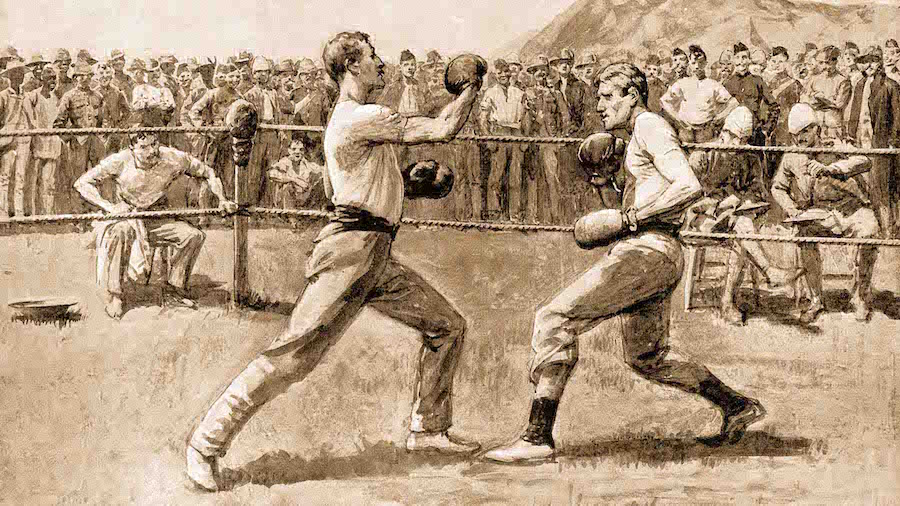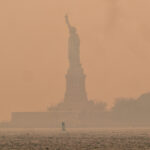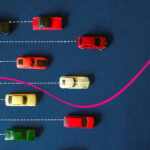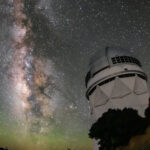Science Journalists Vs. Public Information Officers
In a thoughtful and troubling article here at Cross Sections last Friday, co-anchor Aleszu Bajak wrote that the National Association of Science Writers — the nation’s oldest professional organization for science journalists — “is in the midst of an existential crisis” and that “the internal strife could well tear it apart.”
Bajak’s story described a report by an NASW committee charged with evaluating a constitutional amendment that would allow non-journalist members — mostly communications professionals who write press releases for universities, non-profits and others — to become NASW officers. Currently, the NASW constitution requires that the four officers be journalists.
The committee noted that it’s often hard to tell which members are journalists, which aren’t, and which wander back and forth across that undefended border. Some members told the committee they would leave NASW if the constitution were to be amended; others said they would leave if things didn’t change.
Bajak’s piece has received dozens of comments at this writing, but much of the discussion fails to acknowledge an important point: The battle between journalists and public information officers ended nearly 20 years ago. The PIOs won.

Public relations professionals and science journalists aren’t getting along. Maybe they shouldn’t belong to the same professional group? (Visual by iStock.com)
“Who are science writers these days?” NASW’s president at the time, Richard Harris, asked in the Spring/Summer 1998 issue of NASW’s member publication, ScienceWriters (membership required to view). “And what is the purpose of NASW?”
Back then, NASW had about 1,000 dues-paying constituents who fell into one of two membership tiers: Active Members (journalists) or Associates (public information officers). Because members represented what Harris described as a “continuous spectrum” of jobs, some NASW members — including Harris — reckoned there was no point in maintaining those two different tiers. “Instead,” he noted, “the new constitution recognizes that we are all simply Members.”
Of course, as we all know, that wasn’t entirely true: A small and dissonant caveat was simultaneously added to the constitution stipulating that the officers on NASW’s board must be journalists — a nod to “our journalistic roots,” Harris wrote.
The move was largely designed to placate journalist members like me (I was NASW’s treasurer at the time, and later served as president), who opposed equal membership status for PIOs. But it was a purely political compromise that didn’t mean much. NASW was now officially a more heterogeneous organization.
Given all this, taking the final step today and allowing non-journalists to become officers would be more of a cosmetic change than anything else, as PIOs have held the political — and numerical — advantage in NASW since the Associate Member category was dropped.
That’s not to say that there aren’t reasons for concern. The proposed constitutional amendment animating today’s divisive debate would technically allow an operative of a tobacco lobbying firm like Hill+Knowlton to rise to the presidency of NASW — an outcome that would surely disturb the slumber of founding president and Pulitzer prizewinning science journalist David Dietz.
I don’t think that’s very likely. No such troubling PIO has risen to claim an ordinary board seat in the two decades since full membership was extended, and even if such a candidate were to pursue the organization’s top slot, he or she wouldn’t likely be elected. (I’m aware that the same is being said of Donald Trump.)
Still, it was probably foolish to believe, then as now, that journalists and PIOs — whose goals sometimes overlap, but just as often are at odds — would ever entirely get along within the same dues-paying organization. An organizational break-up might be precisely what we need.
The creation of a National Association of Science Journalists to complement the National Association of Science Writers would permanently end all the arguments. Those who aren’t sure which group they should join might think very hard about where to go — which could be a useful exercise for a lot of us. In the end, some would opt for journalism, while others would embrace institutional work. And those who wander back and forth might join both.
And best of all: Friendships would be preserved. The two groups could meet jointly to share resources and speakers. Officer slots would be open to everyone, in one group or the other. And we’d still get nice discounts on blocks of hotel rooms.










Comments are automatically closed one year after article publication. Archived comments are below.
This discussion makes me sad. I have given many years of volunteer labor for NASW, both on the board and as NASW’s liaison to the Authors Coalition of America. I have friends in both camps of the debate over the nature of journalism, and I would hate to see our organization break apart. That’s because for me, the purpose of NASW is to serve our members in these increasingly difficult times, especially those who are having increasing difficulty making a living as the economic basis of traditional media has vanished. This to me is the meaning of the second part of the NASW statement of purpose, the advancement of the interests of our members, which I proposed as an amendment to the constitution in order to qualify for membership in the AC. I believe that the proposed break would make if more difficult to accomplish this important goal, especially for the people who need it most, the freelances who would probably follow the prestigious journalists into the new NASJ.
This is because of the reality of how and why we receive the AC money, which is what pays for many of the services NASW provides, especially such important ones as travel fellowships, career grants and support for the workshops. I, too, am coming late to the discussion, and I have nothing to contribute to the debate about the definition of journalism. I can, however, offer some clarification on the issue of the Authors Coalition, especially in light of the proposal to split.
First, it’s important to understand how an organization gets into AC. To qualify, it must be be national and not discriminate on any of the commonly prohibited grounds. It must receive no more than a quarter or its income from sources other than dues, publications or conference payments. And it must represent 500 “authors” (or their estates). The combination of these two factors makes me wonder whether the proposed NASJ would be able to qualify for AC membership.
I believe I’ve seen it said that 10% of the membership might leave if the amendment passed. Given NASW’s current membership of around 2300, that might mean 200-300 people leaving for the new NASJ. On the face of it, that doesn’t appear to be enough people to qualify for the AC. As I’ll explain below, AC doesn’t actually count people, but rather checks on the genre survey, and some people count for more than one check (although often not journalists who have only worked as staffers). So it’s possible that NASJ could qualify, but, if so, it might be tight. And, of course, the amount received would be a fraction of what NASW now receives. If, as also suggested, NASJ were to receive funding from a foundation or some other ethically acceptable source, the amount would have to be kept below the prescribed limit in order not to jeopardize the right to receive AC funds. Of course, it could be that a benefactor would be willing to pay so much that AC funds were not necessary, which would be great as long as NASJ stayed in the benefactor’s good graces. By the way, as Richard mentions, NASW has the status of a trade association, which means that it cannot receive tax-free donations. If NASJ were to want to do that, it would have to adopt a different legal status, which would impose different requirements and limitations on its activities.
Next, in response to Richard’s comment that receiving AC money recognizes us as an association of authors, I have to say that as far as the AC is concerned, “author” is a term of art. It carries no implication about any of the considerations that have been discussed in this conversation, such as independence or freedom from conflict of interest or anything of the sort. In AC parlance, it roughly means anyone (or the estate of anyone) who has produced and published (but, with some exceptions, not self-published) works that can reasonably be assumed to have been circulated abroad. Anyone who has filled out the AC genre questionnaire knows that this includes those who have written books of all kinds; are “journalists” (that is, writers for periodicals, both staffers and freelances); have written fiction,poems, translations and reviews of books, art, theater, film and music; and are editors at newspapers and technical and professional presses. In addition, the AC recognizes “authors” of music and visual art. So the whole journalist-nonjournalist debate is irrelevant to AC. The partnership is interested not in journalistic independence but in payment for use of copyrighted material.
As to Earle’s comment that the ad hoc committee report says that NASW’s AC money would not be affected, that is essentially true, except that the amount would very likely be lower if NASW lost 10% of its membership. But given its size, NASW appears unlikely to lose its eligibility.
Given the nature of the discussion thus far, these considerations may appear trivial or crass. But I think they need to be stated in order to make sure that people understand the potential ramifications of what we may be doing.
For myself, I, too, very much wish that there could be a compromise that could keep our venerable organization together while assuaging the feelings of those members who feel themselves demeaned by the current arrangements. I don’t know what that compromise might be, but I agree that we should seek it, and quickly. Having been a freelance writer of magazine articles and books for all of my career, with occasional detours into things such as writing reports for nonprofit groups such as the National Academies, I think that I see the delineation less sharply. And having been an NASW officer and board member, member and chair of several committees, and presenter at the workshops, I appreciate the contributions of members who do many kinds of work. Having read of the Bates Challenge, I’ll offer what I guess we can call the Rodney King Challenge: can’t we find a way to all get along? We’ve done so since Grandpa Shurkin was a baby. It would be a shame to stop now.
You are assuming that the 200-300 odd journalists who would leave are the only ones likely to join a new National Association of Science Journalists. There could be any number of journos out there who have refrained from joining NASW, precisely because of the questions now being hotly debated, who would be happy to join a new NASJ.
This is true. I have no idea how many people would join the hypothetical NASJ. Who knows, I might do so myself, though without also leaving NASW. All I wanted to point out was that this new organization could not receive Coalition funds until it attained the required number of author members. I have no idea how hard or easy that would be. Maybe there are hundreds of “pure” journalists so offended by NASW’s constitution that they have declined to join. My own observations of the journalism landscape over the past two decades lead me to believe that this is not highly likely, but I could very well be wrong.
Thanks so much, Beryl, for this excellent explanation of the high bar a new organization would face if it decided to go it alone without subsidy from a well-heeled philanthropy or corporate sponsor, and how Authors Coalition funding would not be threatened by adoption of the amendment per se.
I also feel compelled to include here, because the numbers have been reported variously in this forum, what the Ad Hoc Committee actually found when it asked how members would react to passage of this amendment:
>>Effect on membership numbers
● 54 people (of 658 complete respondents, or about 8%) say they are likely or extremely likely to leave NASW if the proposed constitutional change is made.
○ 48 of these 54 people selfidentify as journalists.
○ 13% of journalists and 2% of nonjournalists indicate they are likely or extremely
likely to leave if the proposed change is made.
● 25people(4%)saytheyarelikelyorextremelylikelytoleaveifthechangeisnotmade.

○ 20 of these people are PIOs and 4 are journalists. One identifies as “Other.”<<
The Ad Hoc Committee never asked how many people would leave; it combined the two categories "likely" and "very likely" to leave to derive the aggregate number of about 8% (slightly higher for self-described journalists). Would this hold true for the membership broadly, or is this number higher among those journalists who feel strongly about this issue and thus were more likely to return the survey? Only about a quarter of the entire membership felt strongly enough about this issue to even respond to the survey.
Now, I think the loss of even one of our journalist members if this amendment passes, or even one of our nonjournalist members if this amendment does not pass, would be exceptionally regrettable. This is where the leadership of the Board and the officers is most needed now, to assure journalists, freelancers, PIOs and all other science writers that their contributions to the landscape of science writing are equally valued, and to support a mechanism that makes this equity publicly evident. The Board and officers at the time the 1998 amendment passed to eliminate the second-class membership for nonjournalists, stepped up to this challenge, where the conversation was just as heated and the threats to leave if that amendment passed were just as vocal (if not as well quantified as in the Ad Hoc Committee's excellent analysis). In the event, the mass exodus did not happen. NASW did not wink out of existence. Leadership's calm support of this step toward equity made all the difference then and it could now.
As president of NASW in 1989, I worked to abolish the “A” and “B” class of membership because I saw that many members didn’t fall neatly into the journalist camp or the PIO camp. It’s very odd to see that trope reemerge in this current discussion.
To me the matter is quite simple: The president (and president-elect) of NASW should not have a conflict of interest. What might that conflict be? Well, someone who works for the government, or a university or a corporation — and whose job is to nudge news coverage to make their employer look good — has a conflict of interest and should not have a leadership role in an organization that represents journalists.
I don’t see it as a problem for a democratically elected board to include a wide representation of the membership. But I draw the line at leadership. (This is not an issue for local science-writers groups, which serve primarily as social organizations).
It’s also worth considering the purpose of NASW. We serve our members (our tax status puts us in the same category as a chamber of commerce, for instance). We provide meetings and discussion forums. But we also represent journalists in professional and international forums. NASW would not be eligible for the hundreds of thousands of dollars we get from the Authors Coalition if we weren’t recognized as an organization of authors. We also give out journalism awards, in which the judges are journalists, not people primarily funded by institutions.
Read the constitution. It doesn’t say that PIO’s are second-class citizens. It simply spells out conflicts of interest that disqualify people from being officers, and that includes activities that manipulate journalists. If NASW is taken over by people who don’t understand why that’s a conflict of interest, of course I would leave. Any thoughtful journalist would.
Richard, the ad hoc committee’s report specifically says the change would not jeopardize the Authors Coalition money.
I am late to this debate. I weighed in with the investigating committee, recalling the period in the 1990s when I was President of NASW and we tried to professionalize the organization, brining it up to journalism standards seen in counterpart beat reporting groups. I’m stunned to see where this has ended up, and the very idea of putting PIOs in charge of Journalism is so shocking, I honestly thought I was reading false reporting.
If a separate journalists-only group is formed, I would be delighted to join it.
If NASW tips the scales, blowing up the firewall between public relations and journalism I will, at the very least, be highly distressed.
We are in a difficult time, of course: We all know that internet news/blogs/PR/Journalism/social media “reporting” have blurred lines so significantly that no one can confidently predict the future of Big J Journalism. I recently had a briefing from execs at Facebook who told me that 40% of Americans get most or all of their news via Facebook — and that jumps to 70% for Millennials. What is “news” on Facebook — a blur of hyperlinked “stuff” that mixes press releases, corporate promos, snarky social media commentary and actual journalism.
It pains me deeply that colleagues are dying trying to bring truth and depth to public discourse, and their work in the public consciousness stands equally beside a gmish of crap flying at them via Facebook or Yahoo or Huffington Post or Twitter. When I got home from the Ebola epidemic in 2014 and was confined to my apartment for 21 days I had the chance to catch up on media coverage of the outbreak, and was utterly flabbergasted by how much of the narrative was dominated by people who never set foot on the entire continent of Africa, much less in Liberia, Sierra Leone or Gunea in the middle of the epidemic. When is the last time you were certain that a commentary you read about Syria was written by a reporter who’d actually set foot in the Middle East?
I miss the days when a rigid firewall separated the newsroom from the advertising division at the newspaper, when Frank Mankiewicz went to battle with Congress to create clear separations of money and power to protect NPR from the politicians’ cloying demands, when news organizations set aside funds to pay for reporters’ travel in order to assure no accusation of “taking money from the Pentagon” could be leveled against embed reporters…..Sigh.
This is all terribly troubling. I’m sorry so many pals on the PIO side do not see this.
Long ago there was a reporter at the Chicago Tribune by name of Crewdson who spent an inordinate amount of time and money doggedly tracking Robert Gallo, proving the NCI researcher “stole HIV samples” from the Pasteur Institute. To his critics who charged his work amounted to a character assassination Crewdson famously denounced science beat reporters, saying, “they aren’t journalists, they’re stenographers.” We Science Journalists of course took great offense
Flash forward 30 years and maybe Crewdson had a point: will NASW be an association of PR + stenographers?
Them’s my 2 cents.
Laurie is right. So is Richard. I’ve spent parts of my career as a PI, parts as a journalist. NASW is stronger because all sorts of science WRITERS are full members; the standards of quality for science writing are strengthened across the whole range of practice because we all agree that there are standards. PI work, even done very well, does contain inherent conflicts of interest and for that reason the officers of NASW should be journalists, as long as journalism lasts.
I’ve added a few outsider comments on this very interesting discussion here:
http://peterdedmonds.blogspot.com/2016/06/the-value-of-good-communication-between.html
I discuss the value of good communication between science journalists and PIOs, and raise some questions about COI.
So the core objection to the amendment is that membership in an organization whose officers include PIOs would taint or call into question what non-PIOs write?
Sorry not to jump in yesterday. I was lurking at 38,000 feet and I didn’t want to try to double-thumb a comment and make a mess of it.
I’m sorry to see the angry turn in some of the comments. Passion is good. Many journalists and PIOs feel that their work is more than just a job. I certainly do. I don’t just work as a journalist and author. It’s a large part of who I am. So is being a husband and being a father. And a musician. And so on. Journalism is a lot for me, but not everything.
So maybe we can take the passion about our work down just a notch and avoid the kind of unpleasantness that might crop up in, say, a discussion of The Beatles vs. The Rolling Stones. (Showing my age, I know. Bruno Mars vs. The Weeknd?)
Here’s another thought I haven’t seen here yet: PIOs and journalists have different things to talk about at an annual gathering. I spent two years developing a university journalism program a few years ago, and I hope never again to talk about deans, graduate committees, degree requirements, and funding campaigns–things that, I’m guessing, might come up for PIOs from time to time–maybe all the time.
Journalists, on the other hand, have a lot of issues finding sources, getting access, uncovering unethical or unlawful behavior, and selling their work–issues that might not come up so often for PIOs.
So dividing the conversation into two parts–with two organizations–might make sense from simply a practical point of view. I offer this as a possible way to move forward without confronting and resolving all the important issues that have been raised here.
The de facto split has already occurred for many -and there are many who already have not joined up in recent years because of the conflicts they perceive. It’s a tragic situation that our profession has been unable to hire and train more pure journalists. There is a level of investigation that cannot occur and territory you cannot tread when you wear two hats. Journalism is a profession that has retained its integrity only with very clear lines and to the degree lines have blurred, that is damaging to journalism and us all.
Just because a job is important -and all modes of science journalism are- does not make it journalism. Whatever people decide to do they should call things by their right name. If the future belongs to people who do journalism one day and work for companies and institutions the next as matter of course and mix it all up -that may be okay to explain how a science works. it’s not okay when your goal is shining the light of social justice, covering science deeply at the crossroads of society and culture, looking at financial conflicts, following medical errors and the like.
At Aeon, I love to have scientists write about their work -I consider those pieces to be essays by a practitioner on the ground. These are wonderful and 100% transparent as to conflicts.
But these scientist/writers are not the same as people who work in a public relations capacity. It does not matter what degree they hold -what matters is who is paying them for the work and whether all conflicts of interest are crystal clear.
It is all honorable and all very important but it is not all the same.
Paul, in a discussion as passionate as this one, positive, constructive suggestions are always welcome, so you get points in my book for trying. The problem is that your suggestion, well-intentioned as it was, again demonstrates the extent to which non-PIOs misunderstand the role. Based on your brief academic sojourn, you suggest that PIOs might want sessions on the academic bureaucracy (dealing with deans and such) while journalists would have sessions on finding sources and questionable ethical behavior. PIOs know how to deal with the bureaucracy — they do so everyday. They need to know about conflicts of interest, scientific misconduct, regs regarding bio safety or radiation safety — the same things that, in my experience, reporters need to fully understand the stories journalists write and PIOs have to deal with. There is so much complaining by journalists about PIOs who are obstructionists–and the complaints are truly valid. It’s been my experience that if both reporter and PIO really understand the specifics of such situations, one can actually help the other and readers will benefit. It obviously won’t fix the problem of agency bosses who want to run and hide but it would give both players a better chance of fostering good journalism. Focusing on our similarities, rather than the differences, is the only way to move forward. And if an impasse does occur in the future, then members can head for the door. But focusing on hypothetical scenarios that might someday occur seems illogical. Again, just my two cents . . .
“[D]eans, graduate committees, degree requirements, and funding campaigns.”
This is what journalists think science PIOs think and talk about?
Peter,
I wasn’t claiming to know. My point was, frankly, that I don’t know–which I guess I demonstrated. The reason I don’t know is that PIOs and journalists have different issues to discuss among themselves.
Yes, Paul, and journalists and PIOs have many, many issues that are of mutual interest and should be discussed between them. One might be for journalists to learn a little something about what PIOs do, and why. It ain’t so simple as just trying to get cheap publicity!
There are orgs that journalists can join, and orgs for PIOs. NASW is the standard setter for SCIENCE writers. When we’re journalists, we keep our editors from publishing bunko, from giving politicians the same weight as climatologists when there’s real data anout melting icecaps to be published. When we’re PIs, we keep our scientists from hyping research that hasn’t been peer reviewed yet–see U of Maryland, Chocolate Milk for what happens when nobody’s looking at the lack of real research behind some “science.” We have lots to talk anout, as the success of NASW workshops has shown over the years. We have a mutual interest in supporting each other, in upholding the standards of the craft. All the rest is trivia.
Janet, two points please:
First, what are the organization’s for science PIOs? I know of none other than NASW, that have ever addressed the needs of those of us dealing with research.
Second, the main work exposing the U. Of Maryland chocolate milk fiasco was done by Andrew Holtz and me for HealthNewsReview.org. The majority of the mainstream media that covered the initial claims just regurgitated UM’s faulty release and then moved on.
No one has really addressed the excellent commentary by David Dobbs above.
That is, below. We run backwards in time at Undark.
Nobody calls PIOs unethical out loud, yet 8 percent of the survey respondents said the mere taint of having a Jeff Grabmeier or Jill Sakai so much as elected vice president would force them to leave NASW to protect their journalistic purity. (While wiping the crumbs of another University-sponsored free food/open bar party off their laps.) That’s the sort of thing that insults us, yes. Especially those of us who, through education and experience and long-standing membership in this group, have every right to think of ourselves as ethically minded journalists. (I make the distinction between JournalIST and JournalISM, especially since so many of us move between realms of science writing.)
My younger colleagues, most of whom come from science not journalism (because those jobs are gone and/or smart young people avoid them) tell me they have no idea what all these self-righteous baby boomers are woofing at each other about. And they are the future of science writing, not 50- or 60-something mainstream journalists.
So, as much as I admired your analysis Paul, I feel that your prescription of splitting the group would be ruinous to both. The huge proportion of current members who live in both worlds would be forced to choose either/or, maybe both, but most likely, none of the above.
Karl, I lament the tone of your reply as well as its content. You accuse those of us who would leave of righteousness, and of considering PIO work unethical, when in fact many of us would leave of necessity (more on that shortly), and when we recognize fully that, while PIO work is pricess, it is different work (but not lesser) work than journalism, and that the primary interests of the two sorts of work sometimes create conflicts of interest.
I don’t have to see PIO work as unethical (and I don’t) to feel compelled to leave the NASW if this measure passes. I must leave because some of the publications I write for stipulate that I cannot be a member of organizations in which membership might create apparent conflicts of interest. Let’s say we elect as president the fabulous Evelyn Jane, who has written great journalism about animal cognition and marine biology for top markets and has also done and still does some PIO work for, say, Medtronic — she helps them explain their rather admired insulin pumps to the public and clinicians.
Now say I’m writing a story for the New York Thymes Magazine, a top publication with ethics guidelines similar to those of The New York Times Magazine, about how aggressive pricing by the diabetes-equipment industry is bankrupting both families and Medicaid. (I know this area well, as my daughter has Type 1 diabetes.) Let’s further say that while Medtronics prices aggressively, I discover in my research that Medtronics is doing something notable to ease the burden on people who have trouble to pay — and this thing they’re doing is remarkable enough that leaving it unmentioned in the story would be irresponsible.
I think you can see that under the terms of the Thyme’s contract, which states that I cannot write a story in which my membership in any organization might create an appearance of conflict of interest, I am now pretty much fucked. I have to drop the story. I MUST declare the potential/apparent COI, or risk banishment from the Thymes forever. I would look bad. The NASW would look bad.
Obviously I must drop the story — on which I’ve spent weeks. For to continue would be to court disaster for all involved.
This is why I will have to leave the NASW if this measure passes.
This pains me. It also pains me that your and others’ criticisms of supposedly elitist aging baby-boomers (news to all: these strictures apply to younger people writing for the Thymes as well) so often tries to drive divisions between younger members and “mainstream” people in their fifties, such as myself, who often feel as much kinship (I know I do) to NASW members in their 30s and 40s as I do to “50s and 60s mainstream journalists.” Driving that wedge, as you do in your comment, is unconstructive and manipulative. It fails to recognize that I understand pretty well, I think, and empathize with, the positions of people like Tara Haelle, who spoke so eloquently at the meeting last year in response to me when I expressed concerns like those above, and I empathize — every month, good sir — with the difficulty of making ends meet when journalism itself doesn’t pay. I did other work for the first 20 years of my career, Karl. Others of my age and current position in this lovely cruel trade did too. I think I truly empathize where Tara Haelle is coming from. And I value ENORMOUSLY the incredible work many PIOs do.
So — if I may use some old language — cut the jive, will you. It’s sloppy and divisive to paint the many reluctant journalists who feel the must leave as if we’re hostile to freelancers working several arenas, or look down on PIOs, or act out of elitist snobbery.
Will people leave? Yes. For all kinds of reasons. But many of us will leave, with sadness and regret, because we feel we have no choice. The sadness comes from the possible end of an organization — or the necessity of leaving an organization — that has been both useful and fun, and that provides a chance to meet and engage a lot of people with different interests in science and writing.
I’m not saying the fact that many of us will leave should change your goal. Maybe it is right thing to pass the measure. It’s a question that intelligent, well-meaning people can argue over. But it’s not right to accuse those who feel they must leave of doing so from snobbery or a sense of elitism.
I find it best in these situations to talk not about motivations, but actions and consequences. Assume motivations are honorable. Give people the benefit of the doubt. Doing otherwise usually gets it wrong. It inflames rather than cools the debate. It makes a difficult situation turn outright ugly. And there’s already enough ugly in the world.
David, it would be helpful for this conversation if you or someone else could provide a real-life sample of the contractual language you describe. It would be useful to see canonical examples of such language from both a freelance contract and from the sorts of policies that staff writers must follow. I think it may advance this discussion if we were able to go beyond hypotheticals.
What he says. And I’m in my 70s, soon to graduate into my 80s and a life member of this esteemed group. I too would leave.
David, interesting you should pick thr NYT as the standard bearer you expect would snub your writing if NASW officers included PIOs. I asked Phil Corbett, standards editor who makes these calls for the paper, explicitly about this, and in his response — quoted verbatim elsewhere — he told us that this would just not be an issue. Other publications may feel differently, but I have yet to talk with a standards or ethics editor who thinks it would be fine for prospective writers to belong to an organization of mostly nonjournalists (by strict definition) but many PIOs, where said PIOs and other nonjournalists serve on the board and chair many of the NASW’s committees, but would bar the gate if an officer were a nonjournalist. The ad hoc committee reviewed the standards statements of a number of the top outlets for science writers and likewise found no such concerns.
I’m a longtime member of NASW who has served on the board as a member-at-large, and I identify as a journalist. I would welcome a split, though it would be painful at first.
Why? I see an unmistakable distinction: PIOs write stories about their institutions for their institutions, journalists write stories of interest to the general public for their outlets’ audiences. This says nothing about the rough times for journalism, or how PIOs often employ the tools or ethics of journalism (most I’ve met do), or how the words of PIOs now reach a record number of people because many outlets are copy/pasting that work, or how that work is often better than news stories, or how there are bad journalists out there, or any of the other fracas involved in this discussion.
But it is a core distinction that means the difference between, say, covering a sexual assault scandal within the science community with depth, fairness, and care, and choosing to be quiet until months or years of investigation conclude (leaving people who face similar struggles in other communities in the dark). Or promoting an institution’s role in cleaning up an environmental disaster on a campus instead of exploring what caused it in the first place and how to prevent it from happening again. Or writing a story about the pro-oil/anti-renewable energy stance of a university board member, and ignoring that story and what it might say about a larger problem that could exist at a university. Or many other hypothetical examples.
Are stories like this rarer in today’s media climate? Of course. And they certainly don’t get as many clicks as cute animals. But that basic editorial right is still present, and many good journalists are still using it. It should be fostered and encouraged and protected by people who understand the distinction.
Is there gray area? Especially for freelancers who need to eat, and so they use the tools of journalism to write both the stories institutions want written, as well as stories for traditional media outlets? Yes. Acts of journalism come in many shades. But without the backing of a protected editorial mission to shine line in dark places — the rich and powerful be damned — I find it hard to call an act of writing journalism.
As to the funding issue Earle Holland points out: Yes, this would pose a challenge — we all know how well the journalism industry pays! — but plenty of other journalist organizations have figured out how to get it done, so I’m confident a NASJ could, too.
Closed Loop, I get the distinction you describe. You articulated an important difference between PIO work and journalism work very well. It’s important, and it’s an enormous part of why independent journalism is so valuable. I say this as a PIO who has never been a journalist.
So what does that have to do with leadership of NASW? I don’t see the logical step from your argument to the conclusion that journalists shouldn’t be part of NASW anymore if PIOs can lead. No one is suggesting we eliminate journalists from leadership eligibility, after all. I don’t want journalists to secede from NASW, but if you feel you must, I want to know why. Make your case. Anybody: Make the case, explained with clear logic and evidence, in the way I know you good science writers can.
PIOs don’t go through some kind of initiation ceremony where we swear allegiance to a unilateral, principled opposition to journalists exposing ugly truths about institutions. We just can’t pursue those stories ourselves, about our own institution, while we work there. Is it so inconceivable we’d want to ally with journalists in support of their freedom to pursue those stories in a general sense? I want good journalism to make the world better. Why can’t PIOs be partners in advocating for that, and for the resources you need to do that, together?
Rachel: considering that there are a lot more PIO than journalists already, and that the near-term future seems to indicate more new jobs in PIO than in journalism, one can easily argue that there will be less and less journalist voices heard on the board of your association.
Rachel: a minor point . . . You say, “We just can’t pursue those stories ourselves, about our own institution, while we work there.”. The truth is that we can, and probably should. Some of us have and the institutions are better for it, more transparent and better respected. Is doing that extremely risky? Hell yes! Can you get fired? Hell yes. But being a PIO and the first to report a problem at an institution and how it’s going to be fixed to prevent it in the future is good for all concerned. And it reinforces the idea that institutions should be doing the “right” thing, which can mitigate things like the ever-increasing corporatization of American universities. Sermon ended.
You don’t see a conflict of interest when one segment of an organization works for institutions and companies and the government while the other segment has to cover those institutions, companies and the government?
Posted elsewhere but seemingly fitting to follow Pauls logic:
A considerable portion of this discussion has addressed questions of ethics and conflicts of interest and the inference, at the least, that true journalists are perched at a loftier point of that sloped continuum than are non-journalists. Opinions will naturally vary, based on one’s personal situation, but it seems that some posters’ ideas of those issues overlook practices that arguably could be seen as questionable. While some members of NASW and SEJ may see institutional science writers as rife with conflicts, they have no problem allowing those institutions to pay large sums to host their annual meetings. And in some cases, corporations or other entities are allowed to sponsor receptions, breakfasts or other activities, for which they receive some recognition. And in cases where exhibits are allowed, exhibitors will pay for the right to display before attendees. Members and payees all agree that this is acceptable behavior since it allows for lower costs paid be the members and payees supposedly gain access, albeit brief, with writers who might someday mention them in coverage. It’s difficult to see this as anything other than quid pro quo which in most cases would be viewed as a conflict of interest. I would hope, if as predicted here and elsewhere, that if journalists split off to form their National Association of Science Journalists, which one assumes would have fierce ethics and conflict of interest standards, that they would forego those paying institutional venues and gratis receptions, etc. which are obviously corrupting influences.
Paul does his usual excellent job of distillation. I would point out, however, that PIOs were board members long before the two-tier system was abolished. I myself was elected in 1996. There were many before me. One could argue PIO’s “won” — if what you mean by “won” is had a semblance of a say in the institution’s governance — when we were first able to participate in board activities. Of course, under the tw0-tier, regular/associate member categories, associate members were not allowed to vote on any constitutional matters. That didn’t change until the REGULAR members approved that constitutional change.
Paul, I don’t believe it’s accurate to say that journalists’ and science PIOs’ “goals sometimes overlap, but just as often are at odds.” In my experience, our goals usually overlap, and are occasionally at odds.
If I had known a majority of the membership of NASW consisted of public relations people, I probably would never have joined in the first place. I’ll bet a lot of working journalists don’t know that they make up a minority of NASW membership. I like the sound of the National Association of Science Journalists.
The “public relations people” in question do a hell a lot of hard work to advance science journalism, from bringing stories to journalists that they would never have known about otherwise to clarifying arcane points of molecular biology at all hours of the day and night. We don’t get bylines, but a little respect would be appreciated.
Implying that we’re mindless, unethical “flacks” is unnecessary and counterproductive.
I’m not aware of anyone calling PIOs “unethical ‘flacks.'” They aren’t. No one says they are.
I think Paul is right. It may be the only way to save NASW and whatever else emerges. I’d join.
What, precisely, are we “saving” NASW from, then?
Joel: Nobody’s calling PIOs unethical flacks here, but it’s often said (or strongly implied) elsewhere. I perhaps overreacted to Dirk’s comment, which goes beyond the question of the constitutional amendment to say that even full membership by PIOs is a fatally corrupting influence, even though, as Paul points out, that’s been in place for two decades.
The hed, subhed, and illustration on this piece paint the amendment as an effort to “control” NASW, but the question on the table is really just about representation–even Paul concedes that a PIO coup d’état is not a realistic consequence of this amendment, barring the emergence of a Trumpian PIO.
(Thought experiment: Can we imagine such a comparison being made, even in jest, regarding journalist members of NASW?)
“Can we imagine such a comparison [that is, comparing a PIO to Trump] being made, even in jest, regarding journalist members of NASW.”
We don’t need to. We’ve already been compared to practitioners of apartheid and opponents of marriage equality.
Touché.